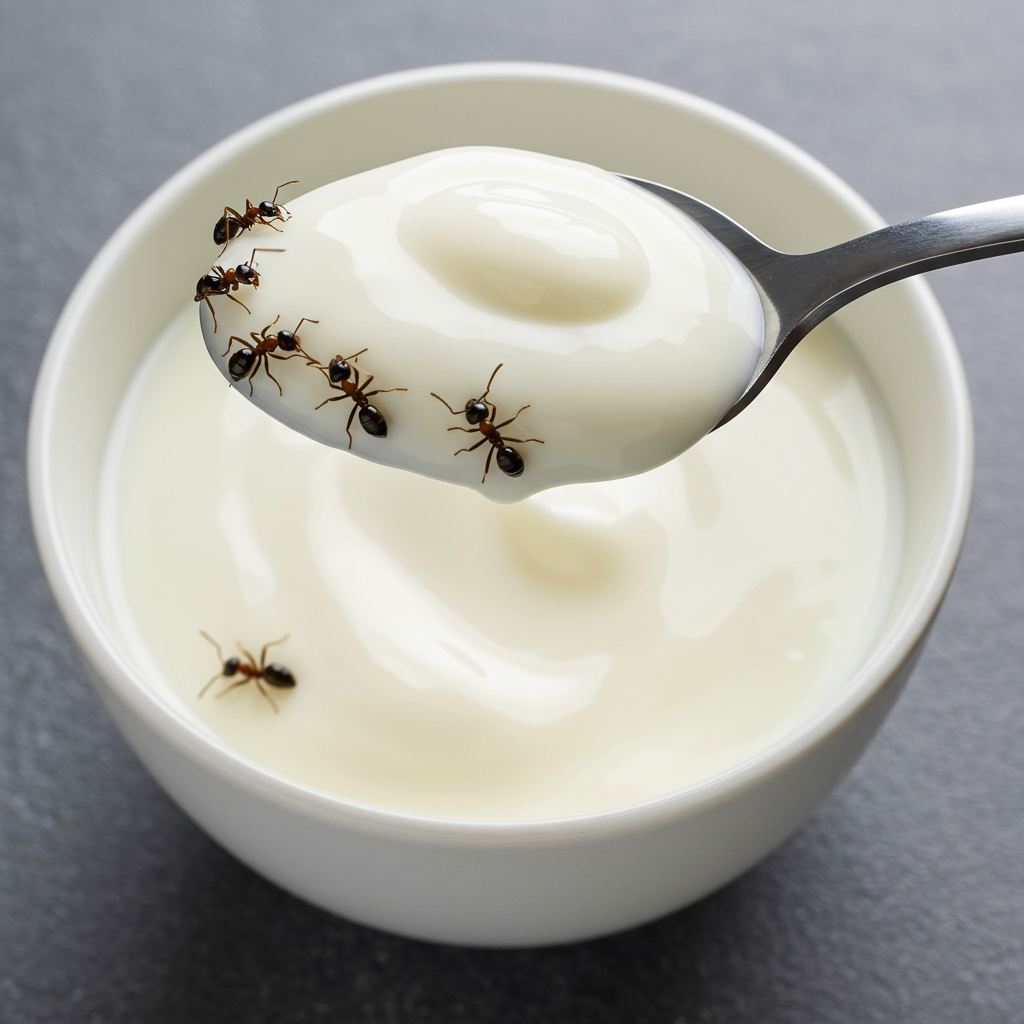The culinary landscape is constantly evolving, with adventurous foodies seeking out novel tastes and unique ingredients. While fermented foods like kombucha, kefir, and sourdough have become mainstream staples, a fascinating new frontier is emerging from an unexpected source: ants. Imagine a spoonful of yoghurt, not from cows or plants, but born from a remarkable collaboration between tiny insects and microbes. This isn’t science fiction; it’s the intriguing reality of ant yoghurt, a surprisingly creamy delicacy with roots in ancient traditions and a promising future in food innovation.
Unearthing an Ancient Fermentation Secret
The concept of ant yoghurt, initially sparking curiosity with its “surprisingly creamy” texture, has captured the imagination of both high-end chefs and dedicated food scientists. While it might sound like a modern gastronomic experiment, this unique fermentation practice traces its origins back to folk traditions in regions like Turkey and Bulgaria. It’s a testament to human ingenuity and the enduring power of local culinary knowledge, now being resurrected and meticulously studied in the name of science. The journey to rediscover this peculiar dairy product began with the insights of Danish scientists.
The Alchemist’s Culinary Quest
The scientific investigation into ant yoghurt was notably catalyzed by the vibrant culinary scene in Copenhagen, Denmark. Renowned research and development chefs from The Alchemist, a two-Michelin-starred restaurant celebrated for its avant-garde approach to food, approached scientists at the University of Copenhagen. Their goal was to delve deeper into the intricate workings of this peculiar fermentation. Ants, appreciated for their distinct acidity, were already a favored ingredient in high-end gastronomy across Copenhagen, prompting chefs to explore their full potential for food innovation. Dr. Leonie Jahn, a senior researcher overseeing the project at the Novo Nordisk Foundation Centre for Biosustainability, highlighted the keen interest of Alchemist’s former R&D head in “science-driven food innovation” and the unique acidic profile of ants.
The Science Behind the ‘Surprisingly Creamy’
At the heart of the research was a fundamental question: what truly drives the transformation of milk into ant yoghurt? Was it merely the formic acid from the ants, or were other, more complex biological processes at play? To unlock these secrets, Dr. Veronica Sinotte and her team embarked on an ethnographic and scientific expedition. Their initial research led them to a village in southern Bulgaria, a region with historical ties to ant yoghurt production. Collaborating with Sevgi Sirakova, a co-author with family connections to the area, the team reconstructed an ancestral recipe. This involved warming cow’s milk until it reached a specific temperature, adding four red wood ants, covering the mixture with cheesecloth, and then burying the pot within an ant mound overnight. The mound provided a stable warmth, while the cheesecloth allowed for potential microbial exchange.
A Collaborative Microscopic Dance
Dr. Sinotte’s initial taste of the traditionally prepared ant yoghurt revealed an “early stage of a nice yoghurt,” characterized by reduced acidity and subtle herbaceous notes. This early success spurred further investigation. Back in the controlled environment of the laboratory, the researchers conducted additional experiments using a related species of red wood ant indigenous to Denmark. The lab-produced yoghurt, notably, presented a thicker consistency and more pronounced lemony notes, suggesting that variations in the ant starter culture’s quantity and composition could influence the final product.
The groundbreaking findings, published in the esteemed journal iScience, unveiled a truly collaborative fermentation process. The insects’ formic acid plays a crucial role by significantly lowering the milk’s pH. This acidic environment, in turn, creates ideal conditions for acid-loving microbes to thrive. Simultaneously, enzymes, either directly from the ants or produced by these specific bacteria, initiate the breakdown of milk proteins, ultimately leading to the desired yoghurt consistency. A key discovery from the Danish research was that only live ants possessed the correct microbial community essential to kickstart this unique fermentation. This collaborative mechanism between insect and microbe is what gives ant yoghurt its distinctive characteristics.
A Fermentista’s Personal Journey (and Ethical Dilemmas)
Inspired by the scientific revelations, Linda Geddes, a self-proclaimed “fermentista” deeply passionate about fermentation, found herself irresistibly drawn to the idea of crafting her own ant yoghurt. However, this pursuit was not without its complexities. Dr. Sinotte and her colleagues strongly advise against home experimentation due to potential health risks, primarily the presence of liver flukes—parasites that can be harmful to humans—in some ant species. Furthermore, concerns about sustainability arise, as red wood ant populations are experiencing declines across many parts of Europe, making large-scale harvesting ecologically unsound.
Navigating these ethical considerations, Geddes spent considerable time weighing the pros and cons. Her curiosity ultimately prevailed, aided by a fortunate discovery: a supplier whose operations actively fund red wood ant reintroduction programs. This allowed her to ethically source the insects. Additionally, with an experienced ant-keeper relative volunteering to care for the remaining ant colony, she aimed to mitigate the impact of using a small number of ants for her experiment.
Crafting Ant Yoghurt at Home (with Caution)
Adapting the methodology outlined in Dr. Sinotte’s iScience paper, Geddes meticulously prepared her experimental batch. She sterilized a pestle and mortar, heated a modest 30ml of milk to 42°C, and then carefully added four crushed ants. To ensure safety and remove any potential parasites or ant fragments, the mixture was then strained through a microbiology-grade sieve. Finally, it was incubated overnight in her regular yoghurt maker.
The outcome was a gelatinous yoghurt, described as having a surprisingly creamy taste. Unlike some of the lab-produced samples, Geddes did not detect prominent lemony notes, but rather a mild bitterness. Overall, she found the result “actually rather nice.” Her personal experiment, while intriguing, underscored the need for caution and ethical sourcing for anyone considering such a venture.
Beyond Curiosity: The Future of Novel Food Innovation
The exploration of ant yoghurt extends far beyond mere culinary curiosity. The researchers envision significant practical applications stemming from their findings. The diverse microbes isolated from ants could serve as an invaluable “toolkit” for developing entirely new food products. This could include innovative plant-based yoghurts, offering exciting dairy alternatives, or introducing novel flavor profiles to existing fermented staples like sourdough. The potential for expanding the spectrum of tastes and textures available to consumers is immense.
Expanding Our Culinary Repertoire
Professor Martin Blaser, a distinguished human microbiome expert at Rutgers University in the US, voiced considerable excitement about this research. He noted that the global popularity of industrial yoghurt production has led to a limited number of bacterial strains dominating the market. While the nutritional value of ant yoghurt might be comparable to industrially produced varieties, this approach could significantly broaden our gastronomic repertoire. For discerning palates, such innovative methods promise to deliver “interesting and unique tastes” that are currently unavailable. The move towards exploring diverse fermentation agents could lead to a renaissance in flavor creation.
Exploring Plant-Based Fermentation Traditions
Interestingly, ants are not the only unusual ingredients historically employed in yoghurt fermentation. In Turkey and other cultures, traditional practices reveal the use of various plant materials to kickstart the process. Ingredients such as pinecones, chamomile, linden flowers, or even nettle roots have historically been utilized. Investigating these plant-based approaches offers a wealth of opportunities to impart further unique textures or flavors to fermented foods. This direction holds the added benefit of avoiding the ethical and ecological concerns associated with harvesting ants, offering a sustainable path forward for culinary innovation. Imagine a nettle yoghurt for breakfast – a testament to how ancient wisdom can inspire future food science.
Frequently Asked Questions
What makes ant yoghurt unique compared to traditional yoghurts?
Ant yoghurt stands out due to its distinctive collaborative fermentation process involving live ants and specific microbes. Unlike traditional yoghurts relying solely on bacterial cultures, ant yoghurt harnesses the ants’ formic acid to lower the milk’s pH, creating an acidic environment where acid-loving microbes thrive. These microbes, along with ant or bacterial enzymes, then break down milk proteins to form the yoghurt. This unique blend results in flavors and textures, like the “surprisingly creamy” consistency and potential lemony or herbaceous notes, that differ from conventional dairy products.
Where did the tradition of making ant yoghurt originate, and how is it being rediscovered?
The tradition of making ant yoghurt originated from ancient folk practices in regions like Turkey and Bulgaria. It involved simple methods, often placing milk and ants in ant mounds to ferment naturally. Its rediscovery was sparked by research and development chefs from Copenhagen’s two-Michelin-starred Alchemist restaurant, who were interested in ants’ acidity for food innovation. This prompted Dr. Veronica Sinotte and her colleagues at the University of Copenhagen to investigate the process, combining field research in Bulgaria with laboratory experiments in Denmark to understand its scientific basis.
Are there ethical or safety concerns about consuming ant yoghurt, and what are its potential future applications?
Yes, there are significant ethical and safety concerns regarding ant yoghurt. Scientists advise against home production due to the risk of ants carrying parasites, such as liver flukes, which are harmful to humans. Additionally, red wood ant populations are declining across Europe, making large-scale harvesting unsustainable. However, the scientific understanding of this fermentation process has profound future applications. The microbes isolated from ants could serve as a “toolkit” for developing novel foods, including innovative plant-based yoghurts, or for introducing unique flavor profiles to existing fermented products like sourdough, without the need to directly use ants.
The journey from a curious folk tradition to a subject of advanced food science underscores the endless possibilities within our culinary world. Ant yoghurt represents not just an unusual delicacy, but a symbol of how ancient wisdom, when combined with modern research, can unlock new avenues for sustainable, flavorful, and diverse food systems for the future.




